Abstract
The southern subspecies of the Least Seedsnipe (Thinocorus rumicivorus rumicivorus) inhabits steppes, water meadows and lagoons, and in Argentina it occurs in Patagonia. During the winter it migrates to central Chile and northeastern Argentina and Uruguay. Farmers believe that these migrating birds feed on their winter crops and apply chemical control methods on them. Since information on the biology of the Least Seedsnipe is scarce, we analyzed eight specimens captured in an oilseed rape (Brassica napus) crop in Chillar, Buenos Aires Province, in July 2004. Mean body weight of the specimens was 54.3 g. No significant morphometric differences were noted between sexes. Mean stomach content weight was 0.42 g, and vegetal contents ranged between 11–67%. The remaining stomach contents were mineral fragments. In decreasing order of predominance, seeds of the following families were found: Polygonaceae, Poaceae, Cyperaceae, Fabaceae, Convolvulaceae, Chenopodiaceae, and Asteraceae. No rests of oilseed rape were found in any of the analyzed stomach contents. We infer that Least Seedsnipe feeds mostly on vegetation growing as weeds in crops. Being this species a target of chemical control by Buenos Aires farmers, we recommend that more thorough diet and foraging studies should be carried out.
References
ARAMBARRI AM (1983)Diferenciación de diez espe-cies de Rumex (Polygonaceae) a través de sus frutos.Revista de la Universidad Nacional de Río Cuarto3:41–60
BALDWIN S, OBERHOLSER H Y WORLEY L (1931) Mea-surements of birds. Scientific Publications of the Cleve-land Museum of Natural History 2:1–165
CABRERA AL Y WILLINK A (1973) Biogeografía de AméricaLatina. OEA, Washington DC
CABRERA AL Y ZARDINI EM (1978) Manual de la florade los alrededores de Buenos Aires. ACME, BuenosAires
CANEVARI M, CANEVARI P, CARRIZO B, HARRIS G,RODRÍGUEZ MATA J Y STRANECK R (1991) Nueva guíade las aves argentinas. Fundación Acindar, BuenosAiresCLARK R (1986) Aves de Tierra del Fuego y Cabo de Hor-nos. Guía de campo. LOLA, Buenos Aires

This work is licensed under a Creative Commons Attribution-NonCommercial 4.0 International License.





